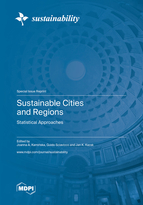Sustainable Cities and Regions – Statistical Approaches
A special issue of Sustainability (ISSN 2071-1050). This special issue belongs to the section "Sustainable Urban and Rural Development".
Deadline for manuscript submissions: closed (31 March 2023) | Viewed by 31841
Special Issue Editors
Interests: air pollution; sustainable urban air quality solutions; particulate matters; nitrogen oxides; pollution concentration modeling; traffic modeling; exhaust gasses
Interests: pure logic to artificial intelligence and machine learning; applications of artificial intelligence to environmental; social; chemical-physical; and food and water fingerprint extraction problems
Interests: sustainable cities and regions; adaptation to climate change; environmental impact assessment; natural resource management; resilience; urban design and planning
Special Issues, Collections and Topics in MDPI journals
Special Issue Information
Dear Colleagues,
The dynamic urbanization leaves a significant mark on the broadly understood quality of life, regardless of the size of the city and the country or continent in which it is located. On the one hand, economic development favors the development of new technologies and availability of many kinds of resources accessible almost without any limits to make life easier. On the other hand, the development of urbanized areas, new transport networks and higher demand for natural resources causes their depletion, pollution of different components of environment, waste production, deforestation, landscape fragmentation, biodiversity losses leading finally to deterioration of living conditions in a longer perspective. Some of these driving forces and pressures as well as responses of the natural environment can be described by characterizing their regularities and patterns. Knowing the quantitative features of many components of socio-environmental systems make it easier to undertake proper actions to mitigate undesirable phenomena. Therefore, various statistical and mathematical techniques (machine learning, regression, classification, spatial analysis and others) can be widely used to solve crucial problems of the current development of cities and regions worldwide to face the challenge of sustainable development at different scales. Mathematical modeling of socio-environmental dependencies allows to draw far-reaching conclusions supporting decision-making process for a more sustainable future. Testing broadly understood statistical hypotheses leads to draw conclusions about the significance of relationships.
This special issue will explore different aspects of urban and regional development with the support of various mathematical and statistical methods. We invite you to publish research carried out all over the world in order to highlight broad perspectives of the domain discussed in this issue.
Relevant topics include but are not limited to the following areas:
- Urban design and city management,
- Regional planning and development,
- Public and private transport,
- Quality of life and living conditions,
- Food systems,
- Pollution of the environment (e.g. air, water, soil),
- Quality of natural resources,
- Climate and its changes,
- Ecological indicators,
with an application of statistical approaches describing these elements.
Dr. Joanna A. Kamińska
Dr. Guido Sciavicco
Dr. Jan K. Kazak
Guest Editors
Manuscript Submission Information
Manuscripts should be submitted online at www.mdpi.com by registering and logging in to this website. Once you are registered, click here to go to the submission form. Manuscripts can be submitted until the deadline. All submissions that pass pre-check are peer-reviewed. Accepted papers will be published continuously in the journal (as soon as accepted) and will be listed together on the special issue website. Research articles, review articles as well as short communications are invited. For planned papers, a title and short abstract (about 100 words) can be sent to the Editorial Office for announcement on this website.
Submitted manuscripts should not have been published previously, nor be under consideration for publication elsewhere (except conference proceedings papers). All manuscripts are thoroughly refereed through a single-blind peer-review process. A guide for authors and other relevant information for submission of manuscripts is available on the Instructions for Authors page. Sustainability is an international peer-reviewed open access semimonthly journal published by MDPI.
Please visit the Instructions for Authors page before submitting a manuscript. The Article Processing Charge (APC) for publication in this open access journal is 2400 CHF (Swiss Francs). Submitted papers should be well formatted and use good English. Authors may use MDPI's English editing service prior to publication or during author revisions.
Keywords
- sustainable city
- sustainable region
- indicator-based evaluation
- quantitative assessment
- mathematical modeling
- statistical analysis








